Nike's Success Factors: A Deep Dive
VerifiedAdded on 2020/05/28
|10
|1771
|52
AI Summary
This assignment delves into the key factors contributing to Nike's success. It examines their strategic marketing approaches, focusing on pricing power, manufacturing cost efficiency, and a growing emphasis on direct-to-consumer sales through retail outlets. The report also explores how these strategies have enabled Nike to achieve financial success and maintain a strong market position.
Contribute Materials
Your contribution can guide someone’s learning journey. Share your
documents today.

Running head: STRATEGIC MANAGEMENT
Strategic Management
Name of the student
Name of the university
Author Note:
Strategic Management
Name of the student
Name of the university
Author Note:
Secure Best Marks with AI Grader
Need help grading? Try our AI Grader for instant feedback on your assignments.
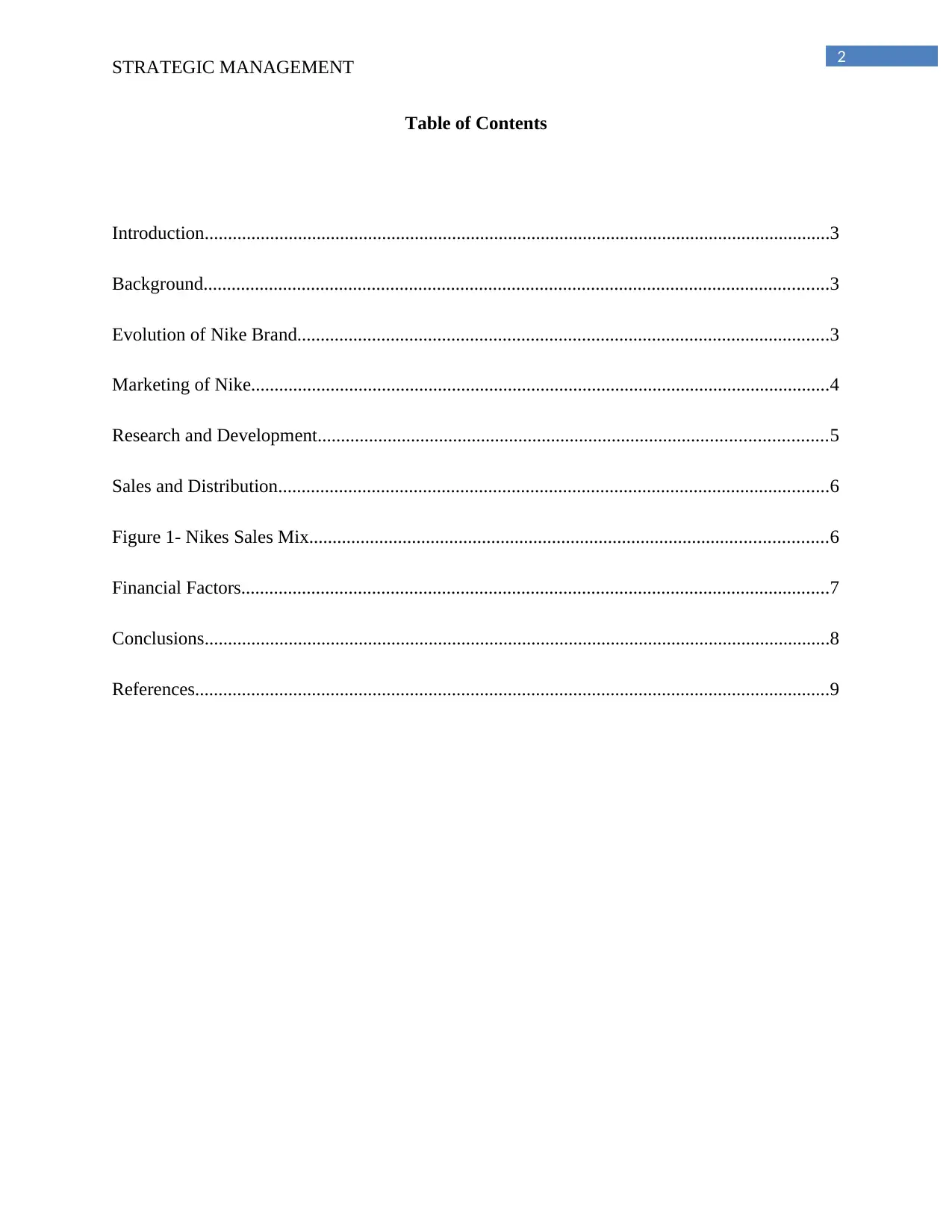
2
STRATEGIC MANAGEMENT
Table of Contents
Introduction......................................................................................................................................3
Background......................................................................................................................................3
Evolution of Nike Brand..................................................................................................................3
Marketing of Nike............................................................................................................................4
Research and Development.............................................................................................................5
Sales and Distribution......................................................................................................................6
Figure 1- Nikes Sales Mix...............................................................................................................6
Financial Factors..............................................................................................................................7
Conclusions......................................................................................................................................8
References........................................................................................................................................9
STRATEGIC MANAGEMENT
Table of Contents
Introduction......................................................................................................................................3
Background......................................................................................................................................3
Evolution of Nike Brand..................................................................................................................3
Marketing of Nike............................................................................................................................4
Research and Development.............................................................................................................5
Sales and Distribution......................................................................................................................6
Figure 1- Nikes Sales Mix...............................................................................................................6
Financial Factors..............................................................................................................................7
Conclusions......................................................................................................................................8
References........................................................................................................................................9

3
STRATEGIC MANAGEMENT
Introduction
The following report has been prepared by the researcher to determine the factors and the
aspects that have led Nike to achieve huge success. The report has aimed to find out the exact
statistics that determines the success factors. The researcher has found it easier to formulate the
project because of the selection of Nike (a global brand). The researcher has provided different
information related to the company to make the report compact in nature. The discussion of the
marketing tactics, sales and distribution, administrative policies of the mentioned company have
been helpful for the readers to gather a clear understanding of the success factors more easily.
Background
Nike Inc. is an American MNC engaged in the designing, manufacturing, development
and sale of footwear, accessories, sportswear and equipment across the globe (www.nike.com).
The company is headquartered in Beaverton, Oregon in USA and is the world’s largest supplier
of athletic shoes and sportswear apparels. It was founded in the year 1964 by Bill Bowerman and
Phil Knight. According to recent reports the company has annual revenue of US$ 30 billion and
an income of around US$ 3 billion.
Evolution of Nike Brand
The period during the 1960’s saw a dominance of canvas sneakers in the US Sports
shoemaker market. The main demand was from the athletes and the professional basketball
players who depended on sneakers heavily. However the period after the 1970’s saw the creation
of a new market (Shishoo, 2015). The common people began to buy the sneakers and other
sports shoes just because of the comfort they offered and the casual style they bought with them.
STRATEGIC MANAGEMENT
Introduction
The following report has been prepared by the researcher to determine the factors and the
aspects that have led Nike to achieve huge success. The report has aimed to find out the exact
statistics that determines the success factors. The researcher has found it easier to formulate the
project because of the selection of Nike (a global brand). The researcher has provided different
information related to the company to make the report compact in nature. The discussion of the
marketing tactics, sales and distribution, administrative policies of the mentioned company have
been helpful for the readers to gather a clear understanding of the success factors more easily.
Background
Nike Inc. is an American MNC engaged in the designing, manufacturing, development
and sale of footwear, accessories, sportswear and equipment across the globe (www.nike.com).
The company is headquartered in Beaverton, Oregon in USA and is the world’s largest supplier
of athletic shoes and sportswear apparels. It was founded in the year 1964 by Bill Bowerman and
Phil Knight. According to recent reports the company has annual revenue of US$ 30 billion and
an income of around US$ 3 billion.
Evolution of Nike Brand
The period during the 1960’s saw a dominance of canvas sneakers in the US Sports
shoemaker market. The main demand was from the athletes and the professional basketball
players who depended on sneakers heavily. However the period after the 1970’s saw the creation
of a new market (Shishoo, 2015). The common people began to buy the sneakers and other
sports shoes just because of the comfort they offered and the casual style they bought with them.
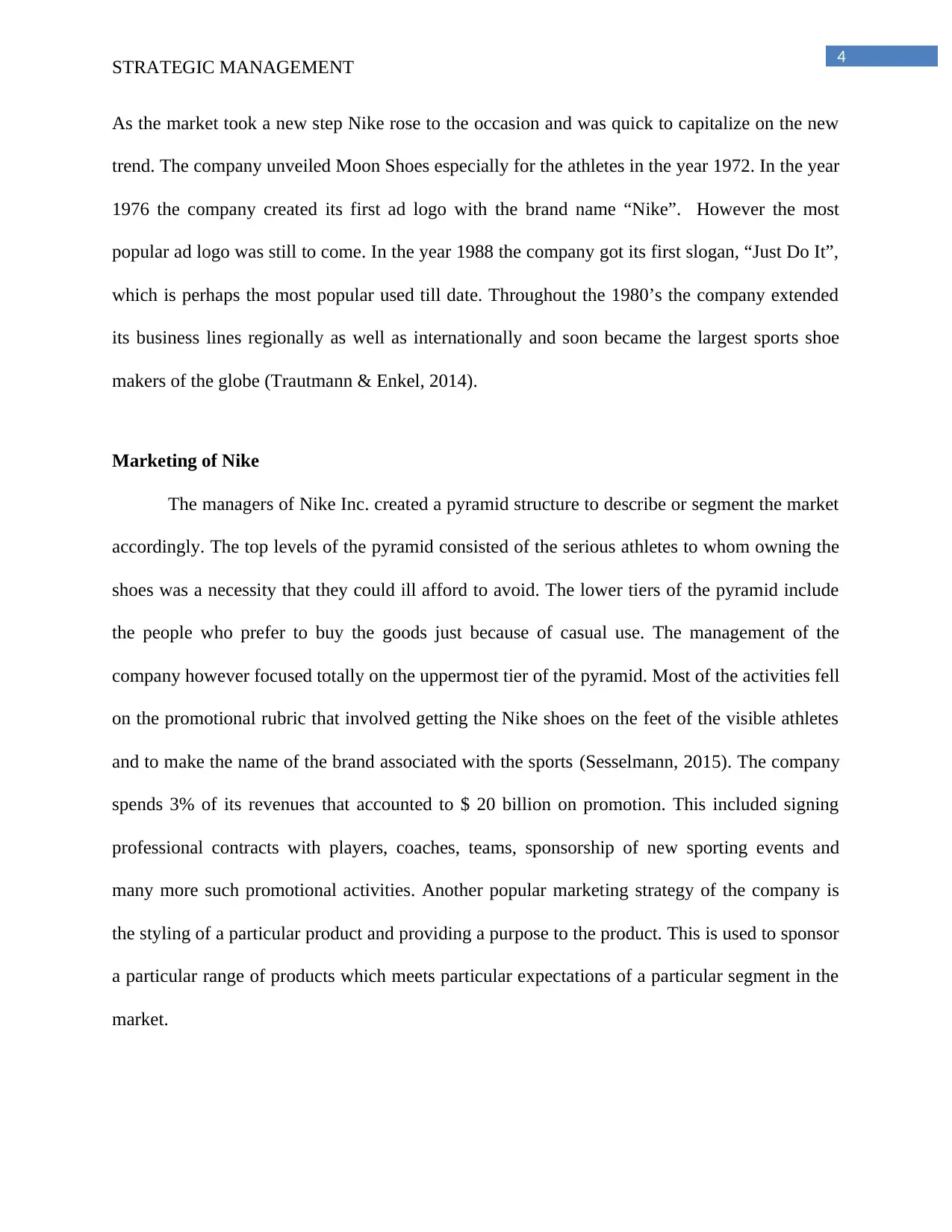
4
STRATEGIC MANAGEMENT
As the market took a new step Nike rose to the occasion and was quick to capitalize on the new
trend. The company unveiled Moon Shoes especially for the athletes in the year 1972. In the year
1976 the company created its first ad logo with the brand name “Nike”. However the most
popular ad logo was still to come. In the year 1988 the company got its first slogan, “Just Do It”,
which is perhaps the most popular used till date. Throughout the 1980’s the company extended
its business lines regionally as well as internationally and soon became the largest sports shoe
makers of the globe (Trautmann & Enkel, 2014).
Marketing of Nike
The managers of Nike Inc. created a pyramid structure to describe or segment the market
accordingly. The top levels of the pyramid consisted of the serious athletes to whom owning the
shoes was a necessity that they could ill afford to avoid. The lower tiers of the pyramid include
the people who prefer to buy the goods just because of casual use. The management of the
company however focused totally on the uppermost tier of the pyramid. Most of the activities fell
on the promotional rubric that involved getting the Nike shoes on the feet of the visible athletes
and to make the name of the brand associated with the sports (Sesselmann, 2015). The company
spends 3% of its revenues that accounted to $ 20 billion on promotion. This included signing
professional contracts with players, coaches, teams, sponsorship of new sporting events and
many more such promotional activities. Another popular marketing strategy of the company is
the styling of a particular product and providing a purpose to the product. This is used to sponsor
a particular range of products which meets particular expectations of a particular segment in the
market.
STRATEGIC MANAGEMENT
As the market took a new step Nike rose to the occasion and was quick to capitalize on the new
trend. The company unveiled Moon Shoes especially for the athletes in the year 1972. In the year
1976 the company created its first ad logo with the brand name “Nike”. However the most
popular ad logo was still to come. In the year 1988 the company got its first slogan, “Just Do It”,
which is perhaps the most popular used till date. Throughout the 1980’s the company extended
its business lines regionally as well as internationally and soon became the largest sports shoe
makers of the globe (Trautmann & Enkel, 2014).
Marketing of Nike
The managers of Nike Inc. created a pyramid structure to describe or segment the market
accordingly. The top levels of the pyramid consisted of the serious athletes to whom owning the
shoes was a necessity that they could ill afford to avoid. The lower tiers of the pyramid include
the people who prefer to buy the goods just because of casual use. The management of the
company however focused totally on the uppermost tier of the pyramid. Most of the activities fell
on the promotional rubric that involved getting the Nike shoes on the feet of the visible athletes
and to make the name of the brand associated with the sports (Sesselmann, 2015). The company
spends 3% of its revenues that accounted to $ 20 billion on promotion. This included signing
professional contracts with players, coaches, teams, sponsorship of new sporting events and
many more such promotional activities. Another popular marketing strategy of the company is
the styling of a particular product and providing a purpose to the product. This is used to sponsor
a particular range of products which meets particular expectations of a particular segment in the
market.
Secure Best Marks with AI Grader
Need help grading? Try our AI Grader for instant feedback on your assignments.
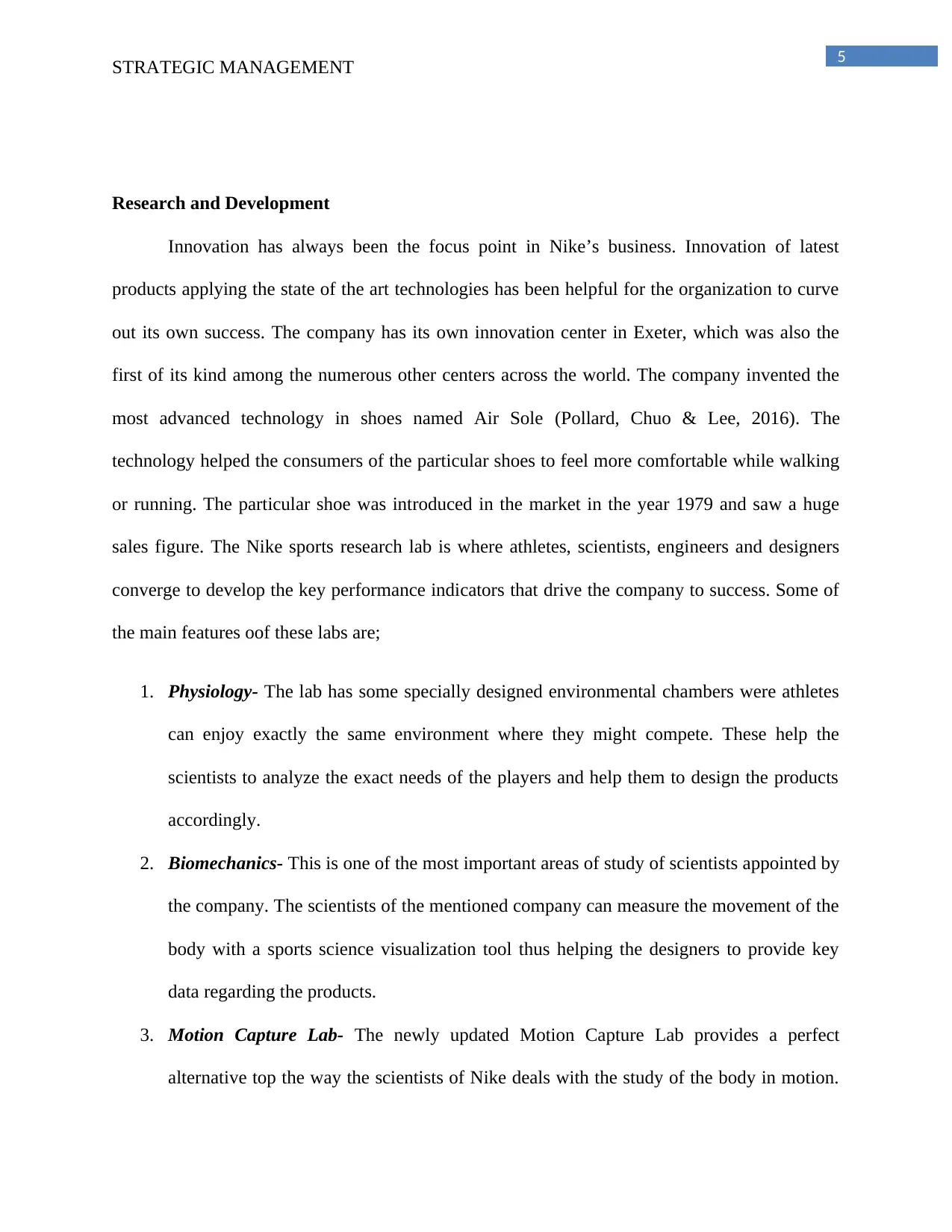
5
STRATEGIC MANAGEMENT
Research and Development
Innovation has always been the focus point in Nike’s business. Innovation of latest
products applying the state of the art technologies has been helpful for the organization to curve
out its own success. The company has its own innovation center in Exeter, which was also the
first of its kind among the numerous other centers across the world. The company invented the
most advanced technology in shoes named Air Sole (Pollard, Chuo & Lee, 2016). The
technology helped the consumers of the particular shoes to feel more comfortable while walking
or running. The particular shoe was introduced in the market in the year 1979 and saw a huge
sales figure. The Nike sports research lab is where athletes, scientists, engineers and designers
converge to develop the key performance indicators that drive the company to success. Some of
the main features oof these labs are;
1. Physiology- The lab has some specially designed environmental chambers were athletes
can enjoy exactly the same environment where they might compete. These help the
scientists to analyze the exact needs of the players and help them to design the products
accordingly.
2. Biomechanics- This is one of the most important areas of study of scientists appointed by
the company. The scientists of the mentioned company can measure the movement of the
body with a sports science visualization tool thus helping the designers to provide key
data regarding the products.
3. Motion Capture Lab- The newly updated Motion Capture Lab provides a perfect
alternative top the way the scientists of Nike deals with the study of the body in motion.
STRATEGIC MANAGEMENT
Research and Development
Innovation has always been the focus point in Nike’s business. Innovation of latest
products applying the state of the art technologies has been helpful for the organization to curve
out its own success. The company has its own innovation center in Exeter, which was also the
first of its kind among the numerous other centers across the world. The company invented the
most advanced technology in shoes named Air Sole (Pollard, Chuo & Lee, 2016). The
technology helped the consumers of the particular shoes to feel more comfortable while walking
or running. The particular shoe was introduced in the market in the year 1979 and saw a huge
sales figure. The Nike sports research lab is where athletes, scientists, engineers and designers
converge to develop the key performance indicators that drive the company to success. Some of
the main features oof these labs are;
1. Physiology- The lab has some specially designed environmental chambers were athletes
can enjoy exactly the same environment where they might compete. These help the
scientists to analyze the exact needs of the players and help them to design the products
accordingly.
2. Biomechanics- This is one of the most important areas of study of scientists appointed by
the company. The scientists of the mentioned company can measure the movement of the
body with a sports science visualization tool thus helping the designers to provide key
data regarding the products.
3. Motion Capture Lab- The newly updated Motion Capture Lab provides a perfect
alternative top the way the scientists of Nike deals with the study of the body in motion.
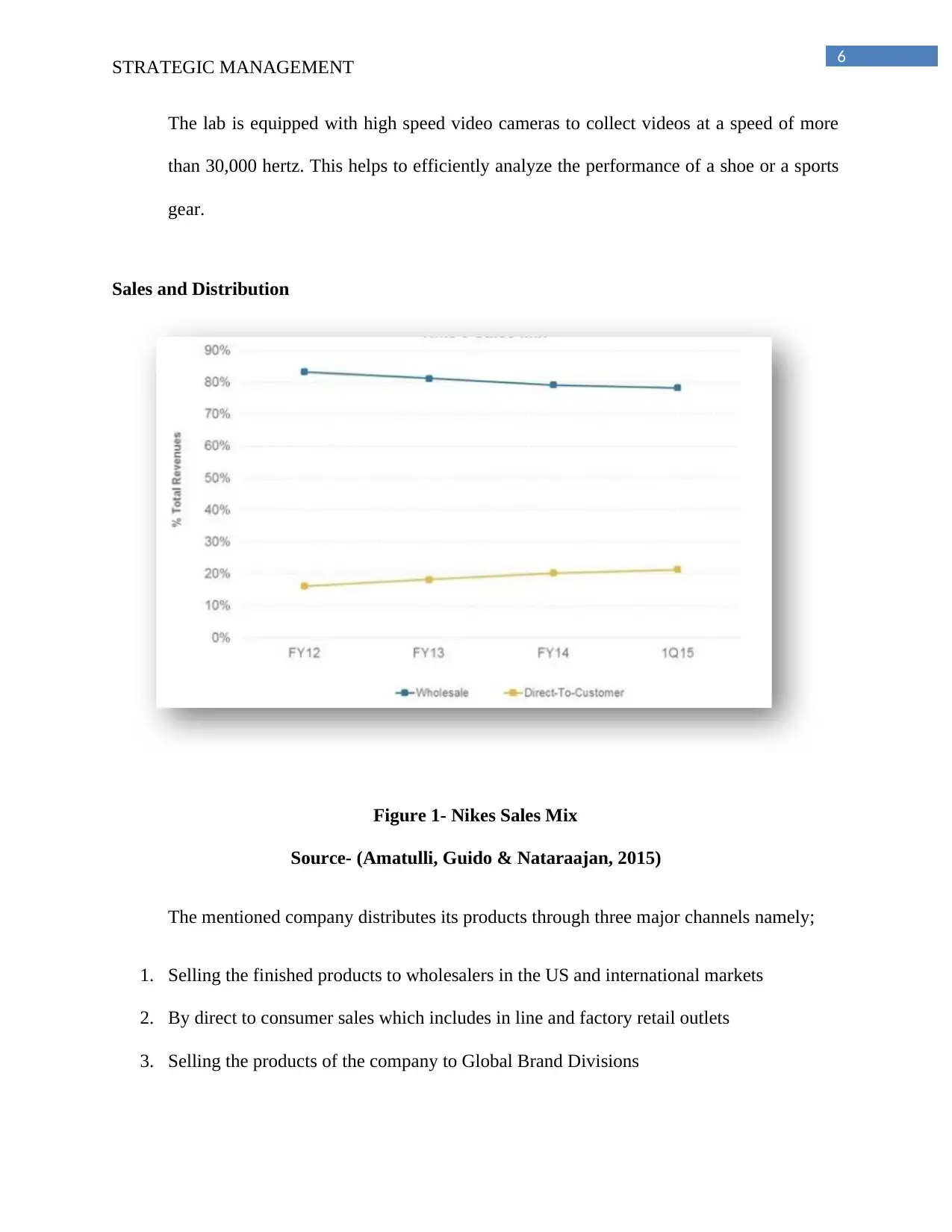
6
STRATEGIC MANAGEMENT
The lab is equipped with high speed video cameras to collect videos at a speed of more
than 30,000 hertz. This helps to efficiently analyze the performance of a shoe or a sports
gear.
Sales and Distribution
Figure 1- Nikes Sales Mix
Source- (Amatulli, Guido & Nataraajan, 2015)
The mentioned company distributes its products through three major channels namely;
1. Selling the finished products to wholesalers in the US and international markets
2. By direct to consumer sales which includes in line and factory retail outlets
3. Selling the products of the company to Global Brand Divisions
STRATEGIC MANAGEMENT
The lab is equipped with high speed video cameras to collect videos at a speed of more
than 30,000 hertz. This helps to efficiently analyze the performance of a shoe or a sports
gear.
Sales and Distribution
Figure 1- Nikes Sales Mix
Source- (Amatulli, Guido & Nataraajan, 2015)
The mentioned company distributes its products through three major channels namely;
1. Selling the finished products to wholesalers in the US and international markets
2. By direct to consumer sales which includes in line and factory retail outlets
3. Selling the products of the company to Global Brand Divisions
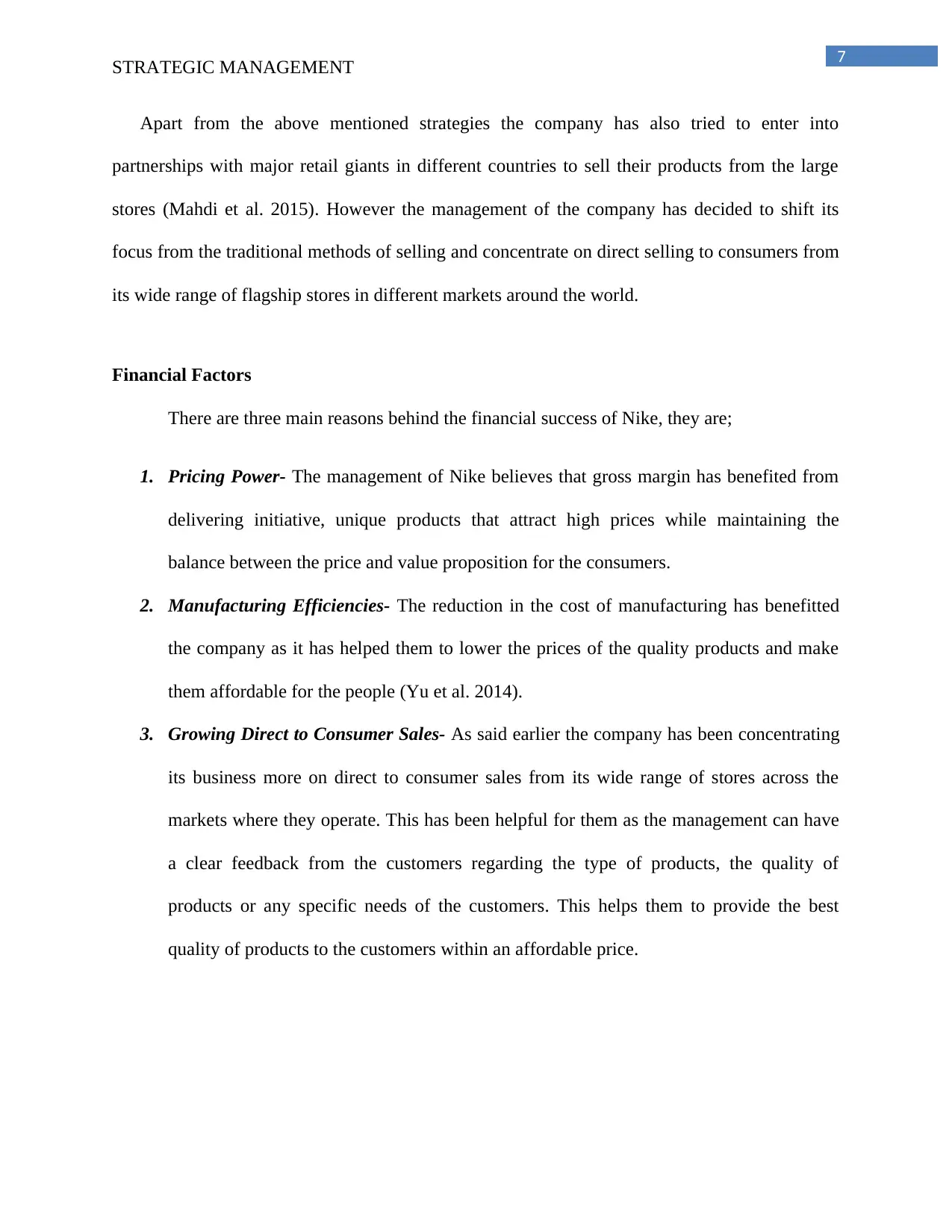
7
STRATEGIC MANAGEMENT
Apart from the above mentioned strategies the company has also tried to enter into
partnerships with major retail giants in different countries to sell their products from the large
stores (Mahdi et al. 2015). However the management of the company has decided to shift its
focus from the traditional methods of selling and concentrate on direct selling to consumers from
its wide range of flagship stores in different markets around the world.
Financial Factors
There are three main reasons behind the financial success of Nike, they are;
1. Pricing Power- The management of Nike believes that gross margin has benefited from
delivering initiative, unique products that attract high prices while maintaining the
balance between the price and value proposition for the consumers.
2. Manufacturing Efficiencies- The reduction in the cost of manufacturing has benefitted
the company as it has helped them to lower the prices of the quality products and make
them affordable for the people (Yu et al. 2014).
3. Growing Direct to Consumer Sales- As said earlier the company has been concentrating
its business more on direct to consumer sales from its wide range of stores across the
markets where they operate. This has been helpful for them as the management can have
a clear feedback from the customers regarding the type of products, the quality of
products or any specific needs of the customers. This helps them to provide the best
quality of products to the customers within an affordable price.
STRATEGIC MANAGEMENT
Apart from the above mentioned strategies the company has also tried to enter into
partnerships with major retail giants in different countries to sell their products from the large
stores (Mahdi et al. 2015). However the management of the company has decided to shift its
focus from the traditional methods of selling and concentrate on direct selling to consumers from
its wide range of flagship stores in different markets around the world.
Financial Factors
There are three main reasons behind the financial success of Nike, they are;
1. Pricing Power- The management of Nike believes that gross margin has benefited from
delivering initiative, unique products that attract high prices while maintaining the
balance between the price and value proposition for the consumers.
2. Manufacturing Efficiencies- The reduction in the cost of manufacturing has benefitted
the company as it has helped them to lower the prices of the quality products and make
them affordable for the people (Yu et al. 2014).
3. Growing Direct to Consumer Sales- As said earlier the company has been concentrating
its business more on direct to consumer sales from its wide range of stores across the
markets where they operate. This has been helpful for them as the management can have
a clear feedback from the customers regarding the type of products, the quality of
products or any specific needs of the customers. This helps them to provide the best
quality of products to the customers within an affordable price.
Paraphrase This Document
Need a fresh take? Get an instant paraphrase of this document with our AI Paraphraser
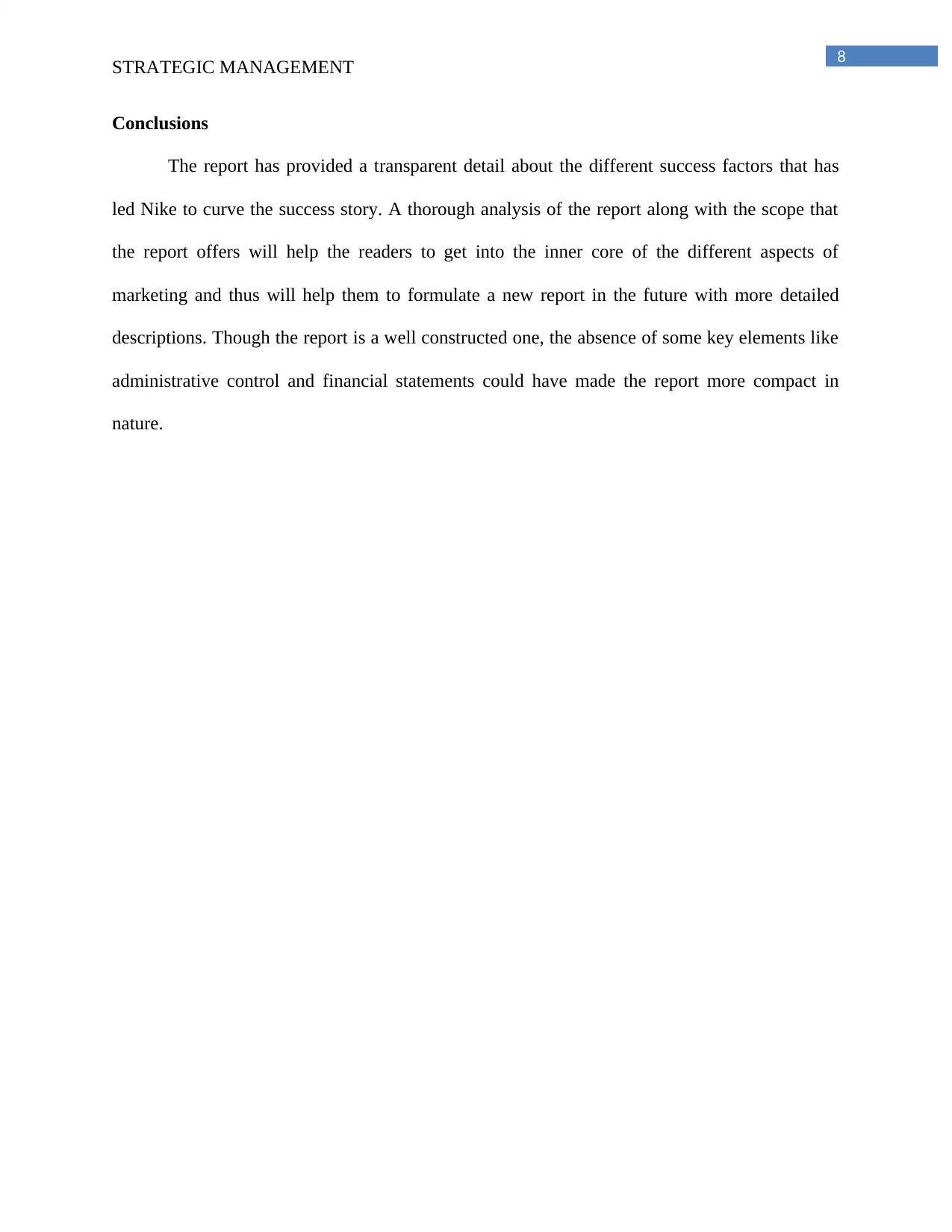
8
STRATEGIC MANAGEMENT
Conclusions
The report has provided a transparent detail about the different success factors that has
led Nike to curve the success story. A thorough analysis of the report along with the scope that
the report offers will help the readers to get into the inner core of the different aspects of
marketing and thus will help them to formulate a new report in the future with more detailed
descriptions. Though the report is a well constructed one, the absence of some key elements like
administrative control and financial statements could have made the report more compact in
nature.
STRATEGIC MANAGEMENT
Conclusions
The report has provided a transparent detail about the different success factors that has
led Nike to curve the success story. A thorough analysis of the report along with the scope that
the report offers will help the readers to get into the inner core of the different aspects of
marketing and thus will help them to formulate a new report in the future with more detailed
descriptions. Though the report is a well constructed one, the absence of some key elements like
administrative control and financial statements could have made the report more compact in
nature.
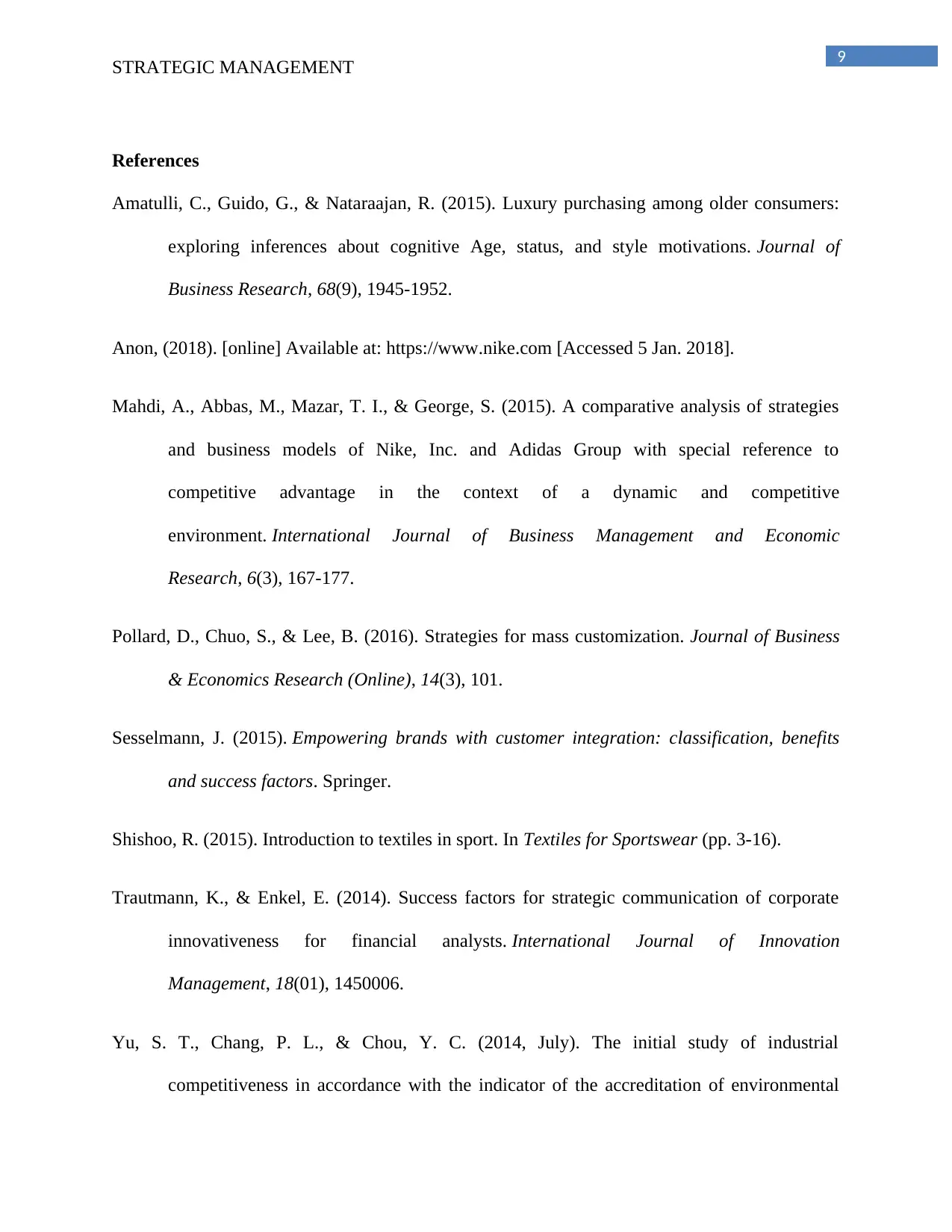
9
STRATEGIC MANAGEMENT
References
Amatulli, C., Guido, G., & Nataraajan, R. (2015). Luxury purchasing among older consumers:
exploring inferences about cognitive Age, status, and style motivations. Journal of
Business Research, 68(9), 1945-1952.
Anon, (2018). [online] Available at: https://www.nike.com [Accessed 5 Jan. 2018].
Mahdi, A., Abbas, M., Mazar, T. I., & George, S. (2015). A comparative analysis of strategies
and business models of Nike, Inc. and Adidas Group with special reference to
competitive advantage in the context of a dynamic and competitive
environment. International Journal of Business Management and Economic
Research, 6(3), 167-177.
Pollard, D., Chuo, S., & Lee, B. (2016). Strategies for mass customization. Journal of Business
& Economics Research (Online), 14(3), 101.
Sesselmann, J. (2015). Empowering brands with customer integration: classification, benefits
and success factors. Springer.
Shishoo, R. (2015). Introduction to textiles in sport. In Textiles for Sportswear (pp. 3-16).
Trautmann, K., & Enkel, E. (2014). Success factors for strategic communication of corporate
innovativeness for financial analysts. International Journal of Innovation
Management, 18(01), 1450006.
Yu, S. T., Chang, P. L., & Chou, Y. C. (2014, July). The initial study of industrial
competitiveness in accordance with the indicator of the accreditation of environmental
STRATEGIC MANAGEMENT
References
Amatulli, C., Guido, G., & Nataraajan, R. (2015). Luxury purchasing among older consumers:
exploring inferences about cognitive Age, status, and style motivations. Journal of
Business Research, 68(9), 1945-1952.
Anon, (2018). [online] Available at: https://www.nike.com [Accessed 5 Jan. 2018].
Mahdi, A., Abbas, M., Mazar, T. I., & George, S. (2015). A comparative analysis of strategies
and business models of Nike, Inc. and Adidas Group with special reference to
competitive advantage in the context of a dynamic and competitive
environment. International Journal of Business Management and Economic
Research, 6(3), 167-177.
Pollard, D., Chuo, S., & Lee, B. (2016). Strategies for mass customization. Journal of Business
& Economics Research (Online), 14(3), 101.
Sesselmann, J. (2015). Empowering brands with customer integration: classification, benefits
and success factors. Springer.
Shishoo, R. (2015). Introduction to textiles in sport. In Textiles for Sportswear (pp. 3-16).
Trautmann, K., & Enkel, E. (2014). Success factors for strategic communication of corporate
innovativeness for financial analysts. International Journal of Innovation
Management, 18(01), 1450006.
Yu, S. T., Chang, P. L., & Chou, Y. C. (2014, July). The initial study of industrial
competitiveness in accordance with the indicator of the accreditation of environmental

10
STRATEGIC MANAGEMENT
management: The case of shoes industry. In Management of Engineering & Technology
(PICMET), 2014 Portland International Conference on (pp. 1667-1673). IEEE.
STRATEGIC MANAGEMENT
management: The case of shoes industry. In Management of Engineering & Technology
(PICMET), 2014 Portland International Conference on (pp. 1667-1673). IEEE.
1 out of 10
Related Documents
Your All-in-One AI-Powered Toolkit for Academic Success.
+13062052269
info@desklib.com
Available 24*7 on WhatsApp / Email
![[object Object]](/_next/static/media/star-bottom.7253800d.svg)
Unlock your academic potential
© 2024 | Zucol Services PVT LTD | All rights reserved.





